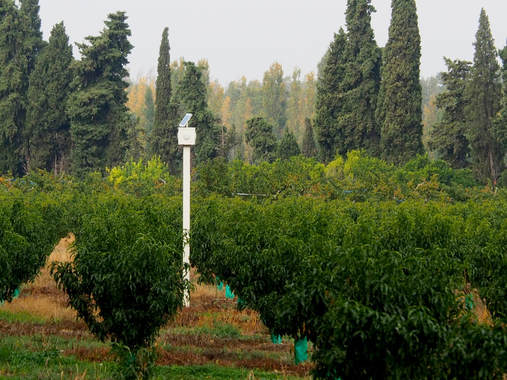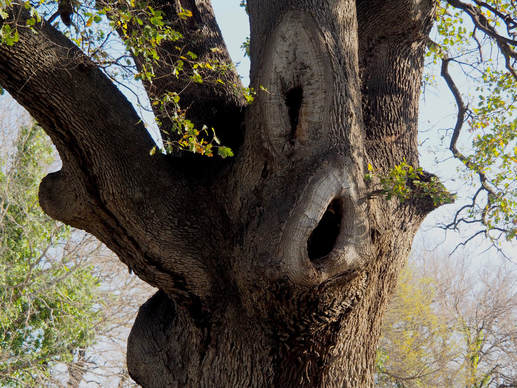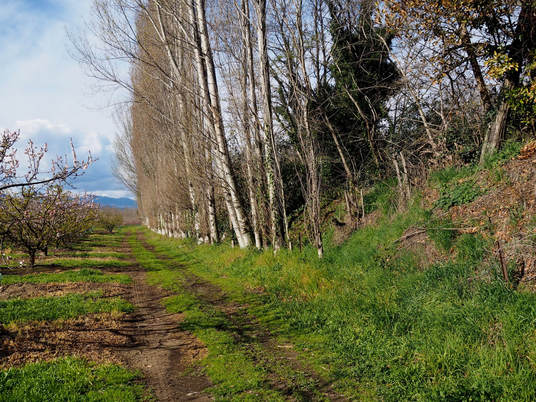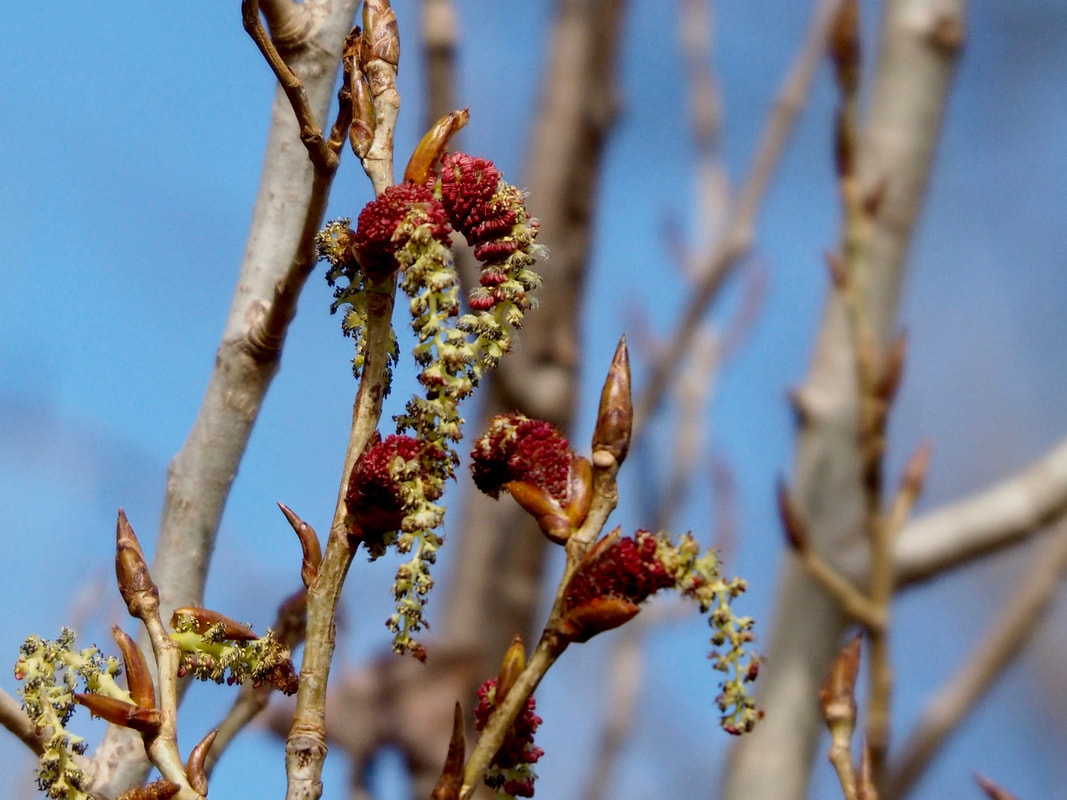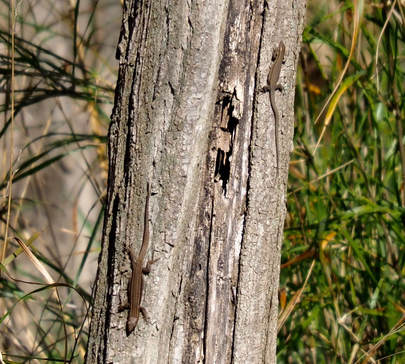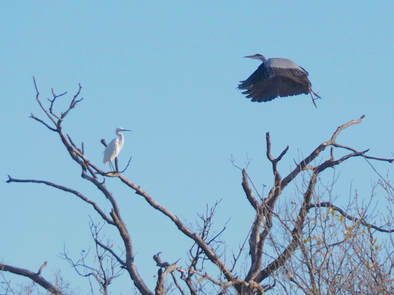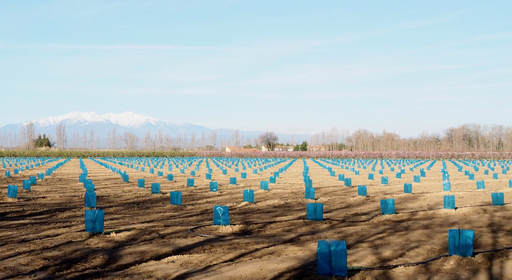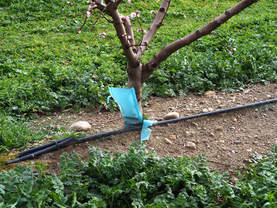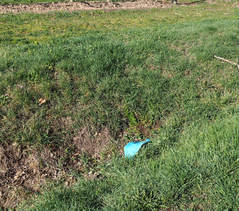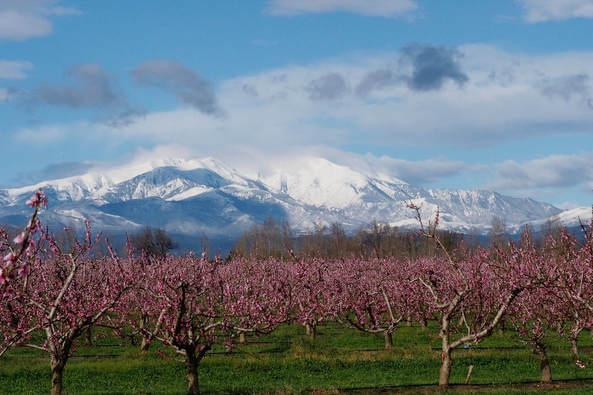Depending on the time of day and direction of the wind, dreadful plinky-plonky noises would drift across the vineyards - a few bars of this, followed by a pause, then a few bars of that. Almost a tune, but not quite. It annoyed me because it clashed with the birds. One day last autumn, when it started up yet again, I gave in to curiosity and changed direction to track down the source. I imagined a house somewhere close by, where an enthusiastic beginner practised, with the windows open. When no house was visible, I next wondered if someone had transported their keyboard to the middle of the orchards and was playing to the trees - a variation on talking to them. There's no accounting for human behaviour, and people play the piano to elephants, after all.
The sound was getting louder; I was closing in. But what I found was, if anything, even more bizarre than I'd imagined.
A tall white pole with loudspeakers on each side of a box at the top. Solar powered. In fact there was a pole every few hundred metres, over several square kilometres. Mercifully, they weren't all belting out the same random notes at the same time, (although I would one day hear two going at once, with different “tunes”). What on earth was the intention behind them? It couldn't be to entertain the fruit pickers, because harvesting was long since over. Surely it couldn't be to encourage growth?
My main reason for putting up with the intrusive, if spasmodic noise, is that this area is much further from the busy main road, and most of the time the only people I see are those working the land. Except for Mondays when several large groups of what I presume are U3A members crisscross the plantations at speed, arms pumping, walking poles clickety-clacking.
Most of this January was spring-like. In contrast, February was much colder, with several sharp frosts - more what you’d expect for winter. Nevertheless, while the so-called Beast from the East and Storm Emma struck much of Europe and the UK, down here, we got off lightly. Nighttime temperatures didn't seem to go below -4°C, and the lowest daytime temperature I noted was 6°C. We've been getting frequent, short-lived but violent southerlies, though - more than I remember in past winters. These have kept temperatures up but brought down several of the tall, thin poplars that border many of the fruit plantations.
The terrain in between each plot of trees also offers more variety of habitats than the side I usually explore. It’s more watery for one thing. There are several deep irrigation ditches, which sometimes run with water, and whose steep banks are covered in interesting vegetation. Last autumn there was plenty of frog activity - every few feet one or two leapt into the water as I walked along the track above them. Then there’s the narrow Canal de Palau, which I guess might have been dug by the Romans originally.
Close to the canal, several big old oaks stand like sentinels in a grassy spot between orchards (first photo in this blog). It's lovely to see they have been preserved. One is particularly huge and ancient-looking. It's lost a lot of limbs to gales over the years, but the main trunk looks solid enough still.
I've seen a fox on patrol, and I imagine badgers may also roam. Otters probably visit the river, or perhaps live on it. With the arrival of true spring weather this week, a hare has appeared three times. Yesterday it was on the track ahead, some distance away but ... haring straight for us. Diggers and I stood still (the dog doubtless unable to believe that lunch might be about to run straight into his mouth). With only a few metres to go, it finally veered off, through the nectarine trees. I expected to see something in pursuit, but nothing showed itself. Hares aren't that common in these parts, and I have a feeling we’re encountering the same one. I hope I’m wrong and that’s it’s not alone.
A different predator has also been at work in the same spot. Diggers has sniffed out the decapitated body of a song thrush. I would have expected a sparrowhawk to have eaten its kill, so I suspect the culprit in this case may have been a magpie, or possibly a jay - there's a big, rowdy gang of jays hanging around, and both species seem to enjoy killing for kicks. I was so sad to see this, not least because it was probably the bird I'd been listening to for about a week. I'd wondered why it had stopped singing, and assumed it had moved on to declare a better territory. Its death won't be wasted if something - one of the buzzards perhaps - benefits from the carrion, but as at today its body lies untouched.
All birds are tuning up now of course. Each time I walk here I'm hearing all three kinds of woodpeckers. Often I'll see the green and great spotted, but the lesser spotted remains elusive (living up to an alternative interpretation of its name, perhaps?). There's quite a lot of drumming going on too - plenty of dead trees for them to raise young in. It would be lovely to locate a green woodpecker's nest hole this year.
A different nest I have noticed is close to the top of an oak tree in the copse I've often visited on the south-eastern edge of this area. The big, twiggy construction is visible only because new leaves haven't quite opened yet. I think it's an old one, but its size - though difficult to judge precisely - makes me wonder if it was perhaps made by buzzards. I've often wondered where the resident pair rears its young - and I know they've been successful at least once. But that really is wishful thinking on my part. There are a few corvids around here too, and it may have belonged to crows for all I know.
Two herons are regulars - often flying overhead between the pond, near the main road where I park the car, and the River Tanyari. Once I was surprised to hear what I thought was one of them calling continuously while perched (invisibly) in a tree. Curious behaviour for a heron. I should have guessed - it turned out to be a jay, imitating.
This was the first time we'd spoken, and his Catalan accent was so strong that for the first ten minutes I only recognised about three words per sentence; all I could do was nod and laugh at what I hoped were appropriate moments. There was mention of a bad back and retirement in a couple of years, and an awful lot about something else. Gradually I got my ear in and gleaned that the Villeclare estate owns 75 hectares of vineyards and orchards. The land with the loudspeakers belongs to someone else.
He explained, with all seriousness, that a certain tiny insect attacks and kills the fruit trees, and that the music is supposed to deter it. "Mozart and the like," he said, "mais ça ne sert à rien." I'm not surprised it's useless - if that's Mozart, I'm Schubert. Besides, I’d love to know what scientific studies have shown that any kind of music will keep away any insects, never mind this species exclusively. And surely it would have to play continuously from spring to autumn - not just for half an hour a day, which seems to be the current schedule.
As the man said, it certainly doesn't seem to be effective, considering the number of diseased trees that were dug up last autumn; work has been ongoing all winter to replace them.
While I have to award points for tackling one problem in an environmentally friendly (other than noise polluting) way, I'm disappointed to see that the same principle isn't applied to other materials used in plantation maintenance. I'm sure I recently read that environmentally friendly tree protectors exist - but I expect they're harder to come by and more expensive than the usual type. Hundreds of plastic cylinders have just been put round young trees in this musical sector of the orchards. I'm not sure if they'll be removed and disposed of properly once the trees are older, but if not, they will simply turn brittle in the fierce summer heat, break up and be dispersed by the wind. To be fair, I haven't yet seen a lot of evidence of this type of litter from past plantings, but much of it might now be too small to notice with the naked eye, or ploughed into the soil.

